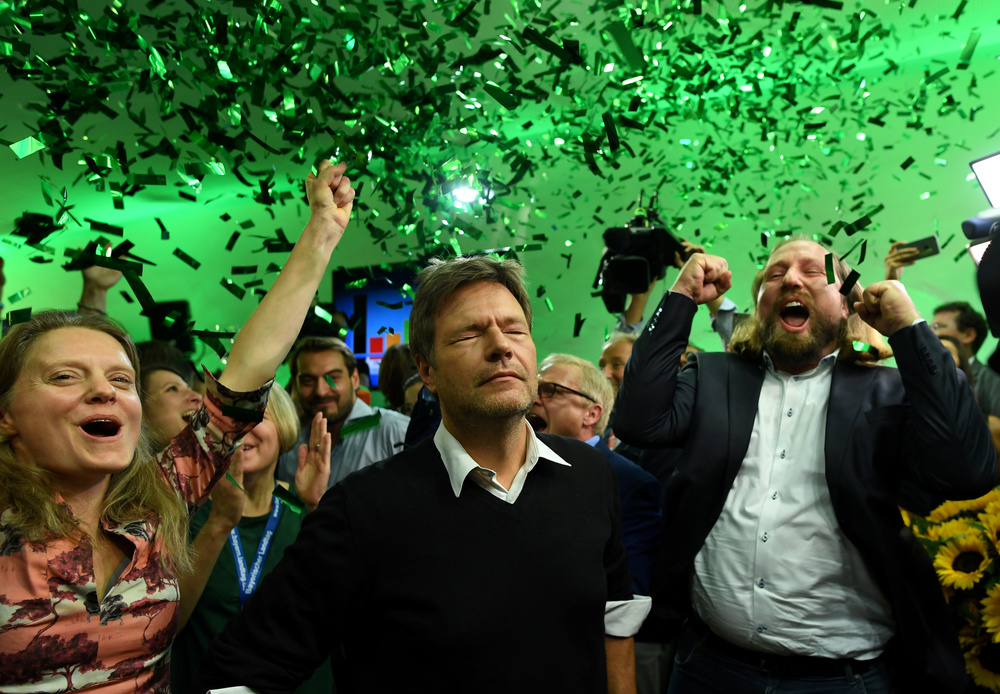
A united European Green front is the only way to deal with the climate emergency along with the other major global partners
In a poll taken by the public television network ARD on 6 June last, the Grünen obtained 26% of the votes in Germany, while the Union of CDU and CSU were only assigned 25%. A major breakthrough. After coming a surprising second in the regional elections in Bavaria last October and securing an unexpected 20% (21 seats) in the latest EU elections, the German Green party are riding high. The media keep asking themselves whether Angela Merkel might be replaced by a Green Chancellor. In the meantime, in Brussels and Strasbourg, the Greens will be a leading force in a European group, the Greens/EFA, that will have greater numbers than expected: 75 seats in total, 23 more compared to 2014. A Euro-party that will certainly carry weight in a very kaleidoscopic parliament that at this point is no longer dominated by the two traditional groupings of the People’s Party and the Socialists. The German Greens will be joined by forces from other countries: the French of EELV (Europe Écologie – Les Verts, who collected 13.47% of the vote, 12 seats), the United Kingdom Green Party (11.77%, 7 seats), and by the green parties (or members of Green/EFA) of Belgium, Denmark, Austria, Spain, Portugal, Finland, Ireland, Luxembourg, Holland, Sweden, Lithuania, Latvia and the Czech Republic.
While everyone in the Union was expecting a populist wave, along came a green wave instead. A success that is clearly down to the new global centrality of the protests against climate change, of which the Fridays For Future movement is one of the more visible manifestations. It can hardly be considered a coincidence that in Germany, one out of every three under-30’s voted for the Grünen, and overall, the younger electorate have been among the main promoters of the growth of the environmentalist movements.
One must however note how in Europe it is still geographically patchy. Italy is the most western European state among those where the Greens didn’t even secure a single seat. In a mapping of green failures our peninsula stands alongside Slovenia and Croatia, then comes Greece followed by Bulgaria and Romania and stretches up to the three Visegrad Group countries: Hungary, Slovakia and Poland. Out of the 28 states of the Union, the Greens won at least one seat in 16, while they collected no seats in the other 12 countries (including Cyprus, Malta and Estonia).
This geographical fracture cannot be ignored by a euro-party with such a proudly pro-European agenda. The Greens can’t settle for being a partial voice within the EU and, given the increasing fragmentation among the various member states, they can’t risk standing as an expression of a specific geopolitical area (in this case mainly Northern and Central Europe, considering the rather limited success of the Green party in the Iberian peninsula).
The Greens success in Germany is based on the development of a counter-populist model. Please note: this is not simply an anti-populist model (meaning a basic reaction to the populist message), but it is an actively counter-populist model because it is focused on planning and developing a different, alternative narrative, that is particularly powerful because it is forward looking and loaded with that emotional urgency that is currently an essential trait of political communication. In Germany, populism found a foothold by dragging the traditional SPD and CDU parties into endless debates on the pressing issue of immigration. In the past year, the Grünen have managed not to get caught up in this kind of dispute. The Greens have instead opted to develop a proposal that is mainly focused on the crucial nature of the climate emergency and have then reviewed the issue of immigration within a context that is defined by the environmental issue itself. The Greens have adopted a similar theoretical and communicative approach to other such divisive issues as identity, Europeanism, and the open society. While within Social Democratic and Christian Democratic circles these values have seemed to be weak and carried little chutzpah, in the Green’s narrative, the open society and European values have been incorporated in the forceful representation of a common, shared and transnational destiny on which the future of the planet depends. These instances have been presented to the Germans by a new leadership with effective media skills, of which the Annalena Baerbock and Robert Habeck duo are the main figures. A leadership that has replaced the previous one without any traumatic and lacerating infighting between different factions (another winning feature when compared to the kind of behaviour witnessed within the traditional German and European parties).
The Grünen have managed to communicate their idea of the future by connecting it to the potential of a green development of production processes, using formulas capable of involving and attracting even a part of the business classes. This has taken place despite the fact that the Greens are openly aiming to achieve a total transition towards renewable energy sources, the complete relinquishing of coal as a fossil fuel and the gradual elimination of the production and consumption of plastic. The radical nature of this project remains, but at the same time (or perhaps for this reason), its promoters are increasingly perceived as the most apt to tackle these current problems and future scenarios.
To achieve a solid, widespread and lasting consensus, the European greens must also find a way to ensure that the costs and effects of this planned environmental conversion are not shouldered by the more disadvantaged sections of society. This will be a fundamental issue in the EU parliament, especially when the Greens/EFA will have to decide who they join forces with and who they intend to collaborate with on specific issues and dossiers, combining a pragmatic political outlook with the goals their own agenda intends to pursue.
The limited success of green parties in the more geographically disadvantaged areas, among factory workers and outside the areas of influence of the main centres is a clear and persistent warning of the importance of retaining a social perspective. One emblematic instance of how this challenge will be met in the coming years can be found in the French EELV Green party. Their leader Yannick Jadot has mirrored the German model and thus managed to revive a party that was historically mired by internal strife. Jadot has even begun to shift towards the centre-left, but mindful of how disastrous their backing of the socialist candidate in the national elections in 2017 turned out to be, this time he refused all alliances for the European elections, including any agreement with President Macron. And EELV’s independence allowed it to become the third player in the main clash taking place in contemporary France: the one between the Palace and the gilets jaunes. On this point, the French Green party appealed for a state that could come up with new policies, that might simultaneously “fight global warming as well as social and territorial inequalities“. An approach that is perfectly aligned to the programme shared by the Green/EFA group.
The need to ensure that ecological and social issues are always tacked together is also very clear in a country like Italy, where concerns over unemployment and stagnant growth have certainly thwarted the chances of environmentalist policies catching on, particularly in a country where political battles are always fought on very short term programmes. The Green Europe ticket that stood at the latest European elections in Italy only secured 2.32% of the vote and was thus way beneath the cut off threshold.
Besides the current contingency, the green parties in Italy pay a price to a number of historical and structural limitations. One of them is undoubtedly the fact that they’ve always been pigeonholed within the more or less radical left. There’s never been a real attempt in Italy to leave this very legitimate niche that has a hard time communicating to the entire electorate. To this one has to add the difficulty in the green narrative in Italy of linking the prospect of an environmental evolution to an idea of technological innovation. Rightly or wrongly, the green brand in Italy seems to be trapped as representing a force of mere environmental conservation, without sufficiently attractive ideas concerning alternative models of progress and the production and goods and services.
On a political level, green issues have most recently been incorporated in the more pro-European fold of the Democratic Party, while a number of instances of territorial protests have been backed by the 5SM. The fact that the Green/EFA group has reiterated its “No” to allowing the 5SM to join its ranks, shows how Italian environmentalism has often worked against the approach adopted by the green wave that is currently spreading throughout Brussels and Strasbourg.
Why the Greens are having a hard time making any inroads in many countries of central and eastern Europe has little to do with the Italian situation. In this case, the reasons seem to be couched in profound historical and cultural motivations, starting with the lack of any kind of environmentalist movements in these area in the 70’s and 80’s which formed the early basis of the ecological movement in Europe now. Moreover, after a period in which the larger Central and Eastern European countries embraced the European integration process – and particularly Hungary and Poland – they have often reacted to the complex issues posed by globalisation by falling back on proud nationalistic stances. This regressive behaviour, at least up to now, has been in sharp contrast to the universal approach often contained in the Green agenda. However, this does not mean that to the east there is no room for new environmentally aware political perspectives. On this front, besides seeing what happens within the EU parliament, it will be interesting to see how the German Grünen play their cards in the future in the East German Länder, where they have never managed to secure much of a following and where many of the social, cultural and political dynamics reflect those witnessed in a number of countries of the former Soviet bloc.
The possibility that the Greens should gain ground throughout is still very much on the cards. In the countries where it is enjoying extraordinary levels of success, with Germany in the forefront, the Greens will probably be called upon to become part of a government, where they’ll have to put the vast credit they’ve obtained in recent times on the line. Italy and the larger central and eastern countries will instead be important testing grounds if they mean to become a cohesive force throughout Europe. As we’ve already indicated, especially in the long term, the European green forces can’t afford to be too geographically uneven and will have to try and build up a European party with seats from many of the Union’s states or, as an alternative, set up specific programme alliances with the countries where the Green parties are weaker. If they manage to achieve a modicum of cohesion and a broad base the new European environmentalism will be strategically undeniable. This is the only chance the Greens will get to face up with the most complex geopolitical challenge of all: the discussion on the climate emergency between Europe and the other major global players, primarily the US, China and India.
@Lorenzomonfreg
This article is also published in the July/August issue of eastwest.
You can buy the magazine at newsstand or subscribe.
A united European Green front is the only way to deal with the climate emergency along with the other major global partners





